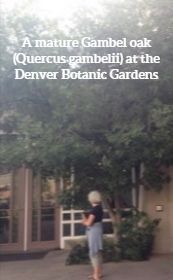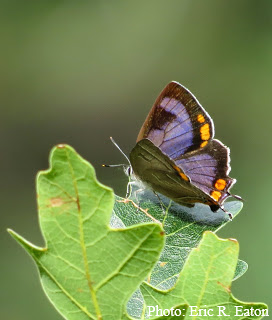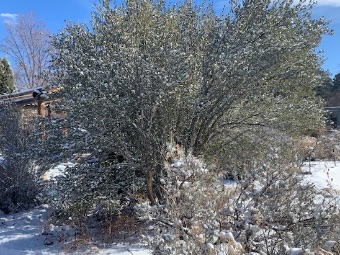by Deborah Lebow Aal
You are right. There aren’t many native trees on the Front Range. I wrote an article on Native Trees for the Colorado Front Range a few years ago, but since we have so many new members, and since it is perhaps the most common question I get (What trees do you recommend?), we will talk about native trees, in general, again. And then I will put a plug in for our native Quercus gambelii, Gambel oak.
 Conventional wisdom is that before European settlers, there were not a lot of trees on the plains of Colorado. It was high plains prairie, here on the Front Range. There were Cottonwoods in the riparian areas, of course, Ponderosa pines in the sub-alpine areas, and other conifers in the mountains, the gnarly Bristlecone pine being my favorite. However, there is a controversial school of thought that says the Front Range was not historically plains. The argument is that Native Americans manipulated a forested landscape many years ago. (See the book “1491”by Charles C. Mann). But, let’s go with conventional wisdom.
Conventional wisdom is that before European settlers, there were not a lot of trees on the plains of Colorado. It was high plains prairie, here on the Front Range. There were Cottonwoods in the riparian areas, of course, Ponderosa pines in the sub-alpine areas, and other conifers in the mountains, the gnarly Bristlecone pine being my favorite. However, there is a controversial school of thought that says the Front Range was not historically plains. The argument is that Native Americans manipulated a forested landscape many years ago. (See the book “1491”by Charles C. Mann). But, let’s go with conventional wisdom.
There is also the question of whether we should be populating the Front Range with trees, now, as we confront dire drought conditions (scientists are labeling the last twenty years as a megadrought, one of the two driest periods in the past 1200 years). Do trees benefit the ecosystem, given the water required to maintain a tree canopy, in this semi-arid part of the country? The answer is that, on balance assuming you select pretty xeric trees, trees give back to the ecosystem way more than they take. The City of Denver estimates that the 2.2. million trees in Denver provide $122 million in environmental services (e.g., soil quality improvement and nutrient cycling). In terms of cooling, they provide $6.8 million in benefits (cooling the city by up to 5 degrees in the summer); and $1.4 billion in stormwater services. That does not include the CO2 reduction trees provide (substantial), wildlife benefits, reduction in air pollutants, and other benefits I’ve surely missed.
And the wildlife benefits deserve to be elaborated. Native trees support many more species of caterpillars and moths than smaller native shrubs, forbs, and grasses., or non-native trees, shrubs, forbs, and grasses. So, you get a much bigger ecosystem bang for your buck by planting a few native trees than you do by planting some of your favorite perennials. To give you some perspective on those numbers, the native perennial forb hosting the most caterpillar and moth species in my zip code is Goldenrod (Solidago), and it host 79 species, waaaay more than any other forb. A Gambel oak, e.g., supports 221 species.1
The bottom line appears to be that it is good to plant trees even on the arid, drought-stricken, Front Range. But I’ll remind you that we need NATIVE trees. I know if you are reading this you know why we need native trees so I will keep this incredibly pithy and unscientific. We need native plants to host the many, many native insects required to feed the next hierarchy of the food web, e.g., birds. That’s it in a very, very oversimplified nutshell. So, herein lies the conundrum. We need trees for ecosystem benefits, and we need native plants for ecosystem benefits, and, there are not a lot of native trees. But, there are a few. And one of my favorites is Quercus gambelii, Gambel oak.


Some would categorize the Gambel oak as a large shrub. I call it a tree. A Gambel oak is simply a fabulous choice for the home landscape, if maintained well. It is gorgeous (okay, my opinion). Closely related to white oak (Quercus alba), it can reach to 50 feet, but most often grows to about 30 feet tall. It is common along Colorado’s Front Range, but is threatened. And it is so important for the ecosystem, as mentioned earlier. In an article in the winter 2020 edition of Aquilegia,the publication of the Colorado Native Plant Society (CoNPS),2 authors Rachael Sitz and Melissa Schreiner discuss their findings on the insect and microbial communities that utilize Gambel oaks. Sitz and Schreiner found 124 species of arthropods (insects, spiders…), representing 57 families in 10 insect orders. This suggests Gambel oaks play an enormously important role in the local ecosystem. Notably, our state insect (who knew?), the Colorado Hairstreak (Hypaurotis crysalus) develops on Gambel oak.
Here, I will introduce the concept of plant “guilds.” A plant guild is a grouping of plants, trees, animals, insects and other components that work together to ensure the health of the plants and their productivity. In nature, you don’t often see a single tree surrounded by a sea of Kentucky blue grass, as you do in many a home landscape. You see plants that naturally thrive around the tree, a grove of the same tree, and plants that benefit each other. Nature is very smart that way. Gambel oaks are found in “the wild” in conjunction with serviceberry (Amelanchier alnifolia), snowberry (Symphoricarpus oreophilus), mountain mahogany (Cercocarpus montanus), and chokecherry (Prunus virginiana).
A guild is a term often used in a permaculture approach to gardening. For those of you curious about permaculture or plant guilds, a great introductory book is Gaia’s Garden, by Toby Hemenway. A Gambel oak guild mentioned in Gaia’s Garden could consist of New Mexico locust, buckthorn, currants, gooseberries, sumac, and elderberry, Apache Plume and prickly pear cacti. I highly recommend Gaia’s Garden except for his section on native plants.3

(photo by Deb Lebow Aal)
For a list of other native trees, see CSU Extension Service’s pamphlet 7.421. Note that this list includes, for example, Willows (Salix). Willows require a wet environment, and are often found growing in riparian areas. Probably not a good choice for home landscapes in this era of drought. Ponderosa pines, also on the list, are a great choice if you have a large landscape, but maybe not on a small urban lot. So, read the list with caution. Still, it’s a very good list to start with and do your research.
And another caveat – my three Gambel oaks are growing very slowly, probably a function of me being extremely thrifty with water. So, my hope is to see many more Gambel oaks in home landscapes, and, as a consequence, many more Colorado hairstreak butterflies! If you are having trouble finding them at nurseries, continue to ask for them. Supply is a function of demand. Demand, demand, and demand again! And, as usual, we’d love to hear from you. If you have a Gambel oak, what has your experience been?
Curious to learn more about transforming your garden into a habitat with Colorado native wildflowers, grasses, shrubs, and trees? Check out our native gardening toolkit, register for an upcoming event, subscribe to our newsletter,
and/or become a member – if you’re not one already!
- National Wildlife Federation’s Native Plant Finder. I find myself referencing this site in every article! ↩︎
- Documenting the Insect and Microbial Communities that Utilize Gambel Oak (Quercus gambelii Nutt.) to Inform Conservation Management, by Rachael Sitz and Melissa Schreiner, Aquilegia Volume 44, No. 1, Winter 2020, page 20-23. This edition does not appear to be online as of this printing. ↩︎
- On page 10 of Gaia’s Garden, Author Toby Hemenway disparages the attention to natives, but does not mention the role natives play in the ecosystem at all. I think he completely missed the point of natives. He states “Native is merely a question of perspective…” which ignores the science behind it. Despite that, I recommend the book as a guide to regenerative (e.g., beyond sustainable) gardening, and for those who want to grow edibles. ↩︎
